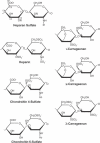Carrageenan is a potent inhibitor of papillomavirus infection
- PMID: 16839203
- PMCID: PMC1500806
- DOI: 10.1371/journal.ppat.0020069
Carrageenan is a potent inhibitor of papillomavirus infection
Abstract
Certain sexually transmitted human papillomavirus (HPV) types are causally associated with the development of cervical cancer. Our recent development of high-titer HPV pseudoviruses has made it possible to perform high-throughput in vitro screens to identify HPV infection inhibitors. Comparison of a variety of compounds revealed that carrageenan, a type of sulfated polysaccharide extracted from red algae, is an extremely potent infection inhibitor for a broad range of sexually transmitted HPVs. Although carrageenan can inhibit herpes simplex viruses and some strains of HIV in vitro, genital HPVs are about a thousand-fold more susceptible, with 50% inhibitory doses in the low ng/ml range. Carrageenan acts primarily by preventing the binding of HPV virions to cells. This finding is consistent with the fact that carrageenan resembles heparan sulfate, an HPV cell-attachment factor. However, carrageenan is three orders of magnitude more potent than heparin, a form of cell-free heparan sulfate that has been regarded as a highly effective model HPV inhibitor. Carrageenan can also block HPV infection through a second, postattachment heparan sulfate-independent effect. Carrageenan is in widespread commercial use as a thickener in a variety of cosmetic and food products, ranging from sexual lubricants to infant feeding formulas. Some of these products block HPV infectivity in vitro, even when diluted a million-fold. Clinical trials are needed to determine whether carrageenan-based products are effective as topical microbicides against genital HPVs.
Conflict of interest statement
Figures





Similar articles
-
Human papillomavirus type 31b infection of human keratinocytes does not require heparan sulfate.J Virol. 2005 Jun;79(11):6838-47. doi: 10.1128/JVI.79.11.6838-6847.2005. J Virol. 2005. PMID: 15890923 Free PMC article.
-
Genital transmission of HPV in a mouse model is potentiated by nonoxynol-9 and inhibited by carrageenan.Nat Med. 2007 Jul;13(7):857-61. doi: 10.1038/nm1598. Epub 2007 Jul 1. Nat Med. 2007. PMID: 17603495
-
Protamine Sulfate Is a Potent Inhibitor of Human Papillomavirus Infection In Vitro and In Vivo.Antimicrob Agents Chemother. 2022 Jan 18;66(1):e0151321. doi: 10.1128/AAC.01513-21. Epub 2021 Nov 1. Antimicrob Agents Chemother. 2022. PMID: 34723633 Free PMC article.
-
A Comprehensive Review of Biologically Active Natural Products on Human Papillomavirus (HPV) at a Glance.Phytother Res. 2025 May;39(5):2262-2290. doi: 10.1002/ptr.8444. Epub 2025 Mar 24. Phytother Res. 2025. PMID: 40127892 Review.
-
Genital human papillomavirus infection.Clin Infect Dis. 2006 Sep 1;43(5):624-9. doi: 10.1086/505982. Epub 2006 Jul 26. Clin Infect Dis. 2006. PMID: 16886157 Review.
Cited by
-
First-in-Human Trial of MIV-150 and Zinc Acetate Coformulated in a Carrageenan Gel: Safety, Pharmacokinetics, Acceptability, Adherence, and Pharmacodynamics.J Acquir Immune Defic Syndr. 2016 Dec 15;73(5):489-496. doi: 10.1097/QAI.0000000000001136. J Acquir Immune Defic Syndr. 2016. PMID: 27437826 Free PMC article. Clinical Trial.
-
Specific Inhibitory Effect of κ-Carrageenan Polysaccharide on Swine Pandemic 2009 H1N1 Influenza Virus.PLoS One. 2015 May 13;10(5):e0126577. doi: 10.1371/journal.pone.0126577. eCollection 2015. PLoS One. 2015. PMID: 25969984 Free PMC article.
-
Algae in Biomedicine.Adv Exp Med Biol. 2024;1470:147-163. doi: 10.1007/5584_2024_795. Adv Exp Med Biol. 2024. PMID: 38353867 Review.
-
Diverse Applications of Marine Macroalgae.Mar Drugs. 2019 Dec 24;18(1):17. doi: 10.3390/md18010017. Mar Drugs. 2019. PMID: 31878264 Free PMC article. Review.
-
Alginates Combined with Natural Polymers as Valuable Drug Delivery Platforms.Mar Drugs. 2022 Dec 23;21(1):11. doi: 10.3390/md21010011. Mar Drugs. 2022. PMID: 36662184 Free PMC article. Review.
References
-
- Schiffman M, Kjaer SK. Chapter 2: Natural history of anogenital human papillomavirus infection and neoplasia. J Natl Cancer Inst Monogr: 14–19; 2003. - PubMed
-
- Koutsky L. Epidemiology of genital human papillomavirus infection. Am J Med. 1997;102:3–8. - PubMed
-
- Manhart LE, Koutsky LA. Do condoms prevent genital HPV infection, external genital warts, or cervical neoplasia? A meta-analysis. Sex Transm Dis. 2002;29:725–735. - PubMed
-
- Mao C, Koutsky LA, Ault KA, Wheeler CM, Brown DR, et al. Efficacy of human papillomavirus-16 vaccine to prevent cervical intraepithelial neoplasia: A randomized controlled trial. Obstet Gynecol. 2006;107:18–27. - PubMed
Publication types
MeSH terms
Substances
Grants and funding
LinkOut - more resources
Full Text Sources
Other Literature Sources
Medical
Research Materials

